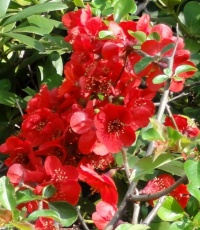Login to edit
An inheritance group references a group of content elements. It extends the functionality of the element group by passing on the content element configuration down the navigation tree.
OpenCms 8.5 Demo Content
Search for content
Page subscription
Most Recent News
Exciting new Acacia variety discovered
Sep 24, 2012
An element group (like this one) allows you to group multiple content elements together and share them on several pages.
Chaenomeles

Chaenomeles is a genus of three species of deciduous spiny shrubs, usually 1–3 m tall, in the family Rosaceae.
They are native to eastern Asia in Japan, China and Korea. These plants are related to the Quince (Cydonia oblonga) and the Chinese Quince (Pseudocydonia sinensis), differing in the serrated leaves, and in the flowers having deciduous sepals and styles that are connate at the base.
The leaves are alternately arranged, simple, and have a serrated margin. The flowers are 3–4.5 cm diameter, with five petals, and are usually bright orange-red, but can be white or pink; flowering is in late winter or early spring. The fruit is a pome with five carpels; it ripens in late autumn.
Chaenomeles is used as a food plant by the larvae of some Lepidoptera species including Brown-tail and the leaf-miner Bucculatrix pomifoliella.
Gardeners in the West often refer to these species as "flowering quince": although all quince have flowers, Chaenomeles are not grown for their fruits. In the 19th and 20th centuries the name "japonica" was widely used (although, since japonica is a specific epithet which is shared by many other plants, this common name is particularly unhelpful). Originally used to refer to C. japonica, the latter common name was (and still is) often loosely applied to Chaenomeles in general, regardless of their species. The most commonly cultivated chaenomeles referred to as "japonica" are actually the hybrid C. × superba and C. speciosa, not C. japonica.
This article uses material from the Wikipedia article Chaenomeles and is licensed under the GNU Free Documentation License.


